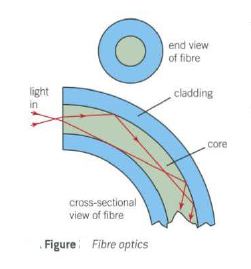How Total Internal Reflection happens in Optical fibres?
Last updated on April 14th, 2021 at 04:53 pm
Optical fibres are used in medical endoscopes to see inside the body, and in communications to carry light signals. These fibres take the help of Total Internal Reflection of light to operate. Now, let’s see how Total Internal Reflection happens in Optical fibres.
How Total Internal Reflection happens in Optical fibres
The light ray is totally internally reflected each time it reaches the fibre boundary.
Even where the fibre bends, unless the radius of the bend is too small, the light rays continuously experience total internal reflection.
At each point where the light ray reaches the boundary, the angle of incidence exceeds the critical angle of the fibre.

Core and Cladding of the Fibre and Total Internal reflection at core-cladding boundary
Each fibre consists of a core surrounded by a layer of cladding of lower refractive index to reduce light loss from the core. Light loss would also reduce the amplitude of the pulses.
Total internal reflection takes place at the core-cladding boundary. At any point where two fibres are in direct contact, the light would cross from one fibre to the other if there were no cladding.
Such crossover would mean that the signals would not be secure, as they would reach the wrong destination.
So when light rays from optically denser core strike the surface of optically rarer cladding with an angle more than the critical angle of the fibre then the total internal reflection of light happens. And this the operating principle of optical fibres.
Communication optical fibre
A communication optical fibre allows pulses of light that enter at one end, from a transmitter, to reach a receiver at the other end.
Such fibres need to be highly transparent to minimise absorption of light, which would otherwise reduce the amplitude of the pulses progressively the further they travel in the fibre.
